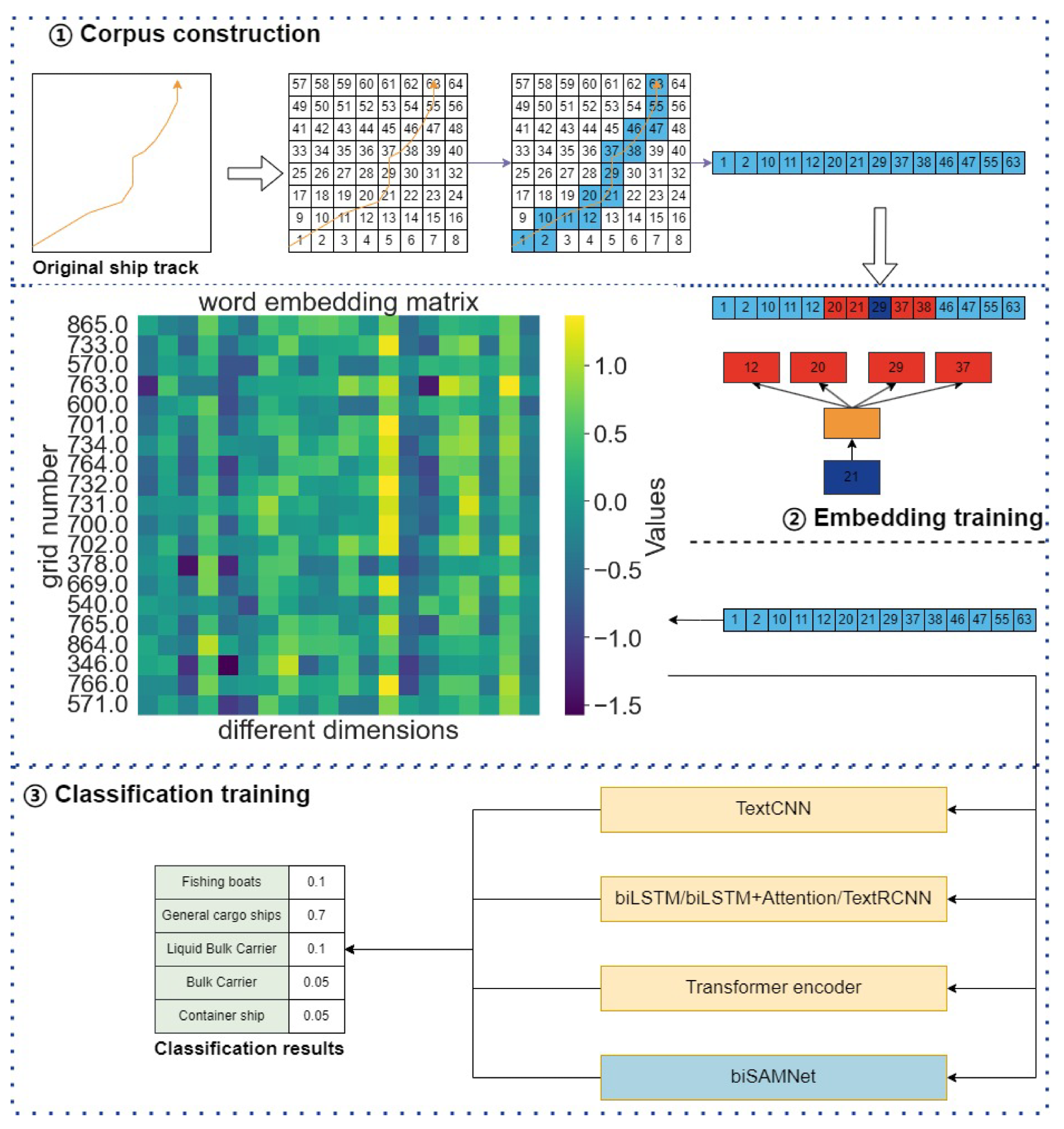In a recent article published in the Journal of Marine Science and Engineering (JMSE), researchers introduced a new model called the bidirectional long-short-term memory (biLSTM) self-attention chunk-max pooling network (biSAMNet) for classifying vessel trajectories. This model integrates word embedding and deep neural network techniques to effectively process and analyze automatic identification system (AIS) data, which is crucial for maritime communication and traffic management.
 Model framework. Image Credit: https://www.mdpi.com/2077-1312/12/6/868
Model framework. Image Credit: https://www.mdpi.com/2077-1312/12/6/868
Background
AIS is a widely used technology in the maritime industry, transmitting a wealth of information about vessels, including their static details (maritime mobile service identity (MMSI), ship name, type, length, and width), dynamic data ( time, speed, heading, real-time position), voyage-related information (destination, cargo type, route plan), and safety-related data (weather reports, navigational warnings).
Leveraging this data can enhance the understanding of vessel navigation and has numerous applications in the maritime field, such as collision prevention, maritime monitoring, trajectory clustering, traffic flow prediction, and ensuring overall maritime safety.
About the Research
In this paper, the authors proposed a hybrid approach that integrates word embedding models with deep neural network models to classify vessel trajectories. The study focused on the Taiwan Strait and its adjacent waters, a critical maritime transportation route for China's coastal regions and the sole direct maritime link between Fujian and Taiwan. This region is known for its challenging navigational conditions, including hidden reefs and shallow areas, making it a historically risky zone for maritime activities.
The researchers first divided the maritime area into a grid of 868 uniformly sized cells. They then transformed the original latitude and longitude coordinates of ship trajectories into text-like information encoded with grid sequences. The Visvalingam-Whyatt algorithm was employed to compress the trajectories, reducing the number of data points while preserving the essential characteristics of the paths.
Next, the study used the word-to-vector (Word2vec) network to train these grid point sequences, obtaining low-dimensional embedding representations. This approach treated each grid point analogously to a word, allowing the researchers to leverage traditional natural language processing (NLP) techniques for the task.
Finally, the authors introduced and benchmarked the biSAMNet model, a novel deep neural network architecture that combines a bidirectional recurrent framework for capturing contextual information and maintaining word order during text representation learning. The biSAMNet model was then used to classify the ship trajectories, identifying static information such as ship types and ship lengths.
Research Findings
The study conducted experiments to evaluate the effectiveness of the biSAMNet model. The outcomes showed that the biSAMNet model outperformed other deep learning models, including convolutional neural networks (CNNs), recurrent neural networks (RNNs), and transformer-based architectures, in classifying vessel trajectories. It also indicated that using pre-trained Word2vec embedding vectors, especially when the layer is frozen, significantly improved the model's performance compared to randomly initialized embeddings.
The Visvalingam-Whyatt algorithm demonstrated remarkable efficacy in streamlining path data, effectively reducing the number of data points while maintaining the essential characteristics of the route. Despite some data point reduction, the core route patterns remained unchanged. Utilizing a small triangle area threshold, the study dynamically determined the optimal number of points to retain, intelligently adapting the level of data simplification to the unique attributes of each trajectory.
In experiments employing an embedding dimension of 100, the biSAMNet model excelled in neural network training. Performance evaluation across three metrics highlighted the superiority of traditional CNN and RNN models over attention-based Transformer models. Notably, the convolutional Text CNN exhibited comparatively lower performance metrics than RNN-related models. Among RNNs, the addition of an attention layer to biLSTM yielded improved results. Ultimately, the biSAMNet model demonstrated superior effectiveness when compared to other models assessed in the study.
Applications
The results of this paper have several practical applications in the maritime industry. The ability to accurately classify vessel trajectories based on ship types and lengths can contribute to various maritime applications, such as:
- Collision prevention: By understanding the characteristics of vessel trajectories, the proposed approach can aid in developing more effective collision avoidance systems, thereby reducing the risk of maritime accidents.
- Maritime monitoring: The classification of vessel trajectories can enhance maritime surveillance and monitoring efforts, helping to identify potential threats or anomalies and improving overall security.
- Traffic flow prediction: The insights gained from trajectory classification can be used to improve the accuracy of maritime traffic flow predictions, which is crucial for efficient resource allocation and planning in busy maritime routes.
- Maritime safety: The findings can be integrated into decision support systems to enhance overall maritime safety, particularly in challenging navigational areas like the Taiwan Strait, by providing better situational awareness and risk management.
Conclusion
In summary, the presented biSAMNet model emerged as a promising tool for accurately categorizing ship paths based on grid sequences. It could effectively enhance maritime safety measures and improve vessel navigation strategies. The effectiveness of pre-trained word embeddings could be helpful for understanding and analysis of AIS data. Moving forward, future research could focus on expanding the methodology to global maritime regions and addressing challenges related to sample imbalance and multi-class classification in vessel trajectory analysis.